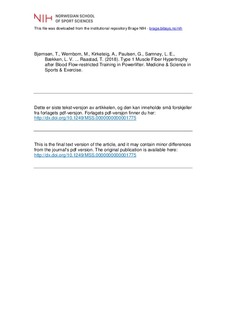| dc.contributor.author | Bjørnsen, Thomas | |
| dc.contributor.author | Wernbom, Mathias | |
| dc.contributor.author | Kirketeig, Alexander | |
| dc.contributor.author | Paulsen, Gøran | |
| dc.contributor.author | Samnøy, Lars Edvin | |
| dc.contributor.author | Bækken, Lasse Vestli | |
| dc.contributor.author | Cameron-Smith, David | |
| dc.contributor.author | Berntsen, Sveinung | |
| dc.contributor.author | Raastad, Truls | |
| dc.date.accessioned | 2019-08-14T09:30:23Z | |
| dc.date.available | 2019-08-14T09:30:23Z | |
| dc.date.created | 2018-09-28T10:31:27Z | |
| dc.date.issued | 2018 | |
| dc.identifier.citation | Medicine & Science in Sports & Exercise. 2018, 51, 288-298 | nb_NO |
| dc.identifier.issn | 0195-9131 | |
| dc.identifier.uri | http://hdl.handle.net/11250/2608251 | |
| dc.description | I Brage finner du siste tekst-versjon av artikkelen, og den kan inneholde ubetydelige forskjeller fra forlagets pdf-versjon. Forlagets pdf-versjon finner du på insights.ovid.com / In Brage you'll find the final text version of the article, and it may contain insignificant differences from the journal's pdf version. The definitive version is available at insights.ovid.com | nb_NO |
| dc.description.abstract | PURPOSE: To investigate the effects of blood flow restricted resistance exercise (BFRRE) on myofiber areas (MFA), number of myonuclei and satellite cells (SC), muscle size and strength in powerlifters. METHODS Seventeen national level powerlifters (25+/-6 yrs [mean+/-SD], 15 men) were randomly assigned to either a BFRRE group (n=9) performing two blocks (week 1 and 3) of five BFRRE front squat sessions within a 6.5-week training period, or a conventional training group (Con; n=8) performing front squats at ~70% of one-repetition maximum (1RM). The BFRRE consisted of four sets (first and last set to voluntary failure) at ~30% of 1RM. Muscle biopsies were obtained from m. vastus lateralis (VL) and analyzed for MFA, myonuclei, SC and capillaries. Cross sectional areas (CSA) of VL and m. rectus femoris (RF) were measured by ultrasonography. Strength was evaluated by maximal voluntary isokinetic torque (MVIT) in knee extension and 1RM in front squat. RESULTS: BFRRE induced selective type I fiber increases in MFA (BFRRE: 12% vs. Con: 0%, p<0.01) and myonuclear number (BFRRE: 17% vs. Con: 0%, p=0.02). Type II MFA was unaltered in both groups. BFRRE induced greater changes in VL CSA (7.7% vs. 0.5%, p=0.04), which correlated with the increases in MFA of type I fibers (r=0.81, p=0.02). No group differences were observed in SC and strength changes, although MVIT increased with BFRRE (p=0.04), whereas 1RM increased in Con (p=0.02). CONCLUSION Two blocks of low-load BFRRE in the front squat exercise resulted in increased quadriceps CSA associated with preferential hypertrophy and myonuclear addition in type 1 fibres of national level powerlifters. | nb_NO |
| dc.language.iso | eng | nb_NO |
| dc.subject | ishemic training | nb_NO |
| dc.subject | kaatsu | nb_NO |
| dc.subject | myogenic stem cells | nb_NO |
| dc.subject | myonuclear addition | nb_NO |
| dc.subject | myonuclear domain | nb_NO |
| dc.subject | athletes | nb_NO |
| dc.title | Type 1 Muscle Fiber Hypertrophy after Blood Flow–restricted Training in Powerlifter | nb_NO |
| dc.title.alternative | Type 1 Muscle Fiber Hypertrophy after Blood Flow–restricted Training in Powerlifter | nb_NO |
| dc.type | Journal article | nb_NO |
| dc.type | Peer reviewed | nb_NO |
| dc.description.version | acceptedVersion | nb_NO |
| dc.source.pagenumber | 46 | nb_NO |
| dc.source.journal | Medicine & Science in Sports & Exercise | nb_NO |
| dc.identifier.doi | 10.1249/MSS.0000000000001775 | |
| dc.identifier.cristin | 1615508 | |
| dc.description.localcode | Seksjon for fysisk prestasjonsevne / Department of Physiscal Performance | nb_NO |
| cristin.unitcode | 150,31,0,0 | |
| cristin.unitname | Seksjon for fysisk prestasjonsevne | |
| cristin.ispublished | true | |
| cristin.qualitycode | 2 | |
